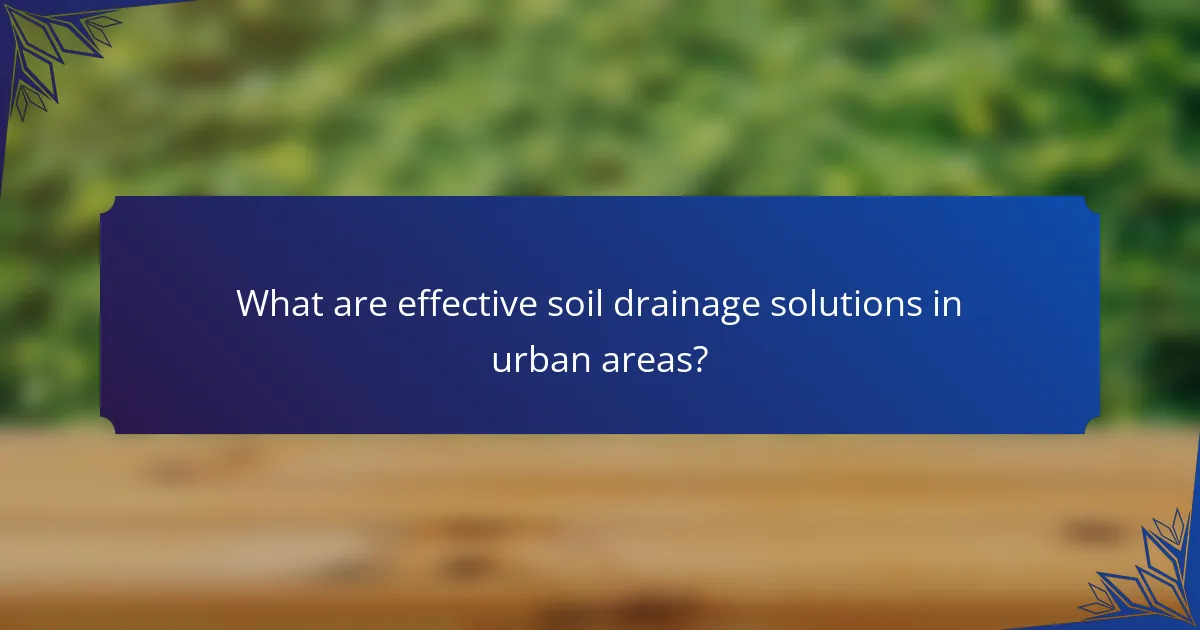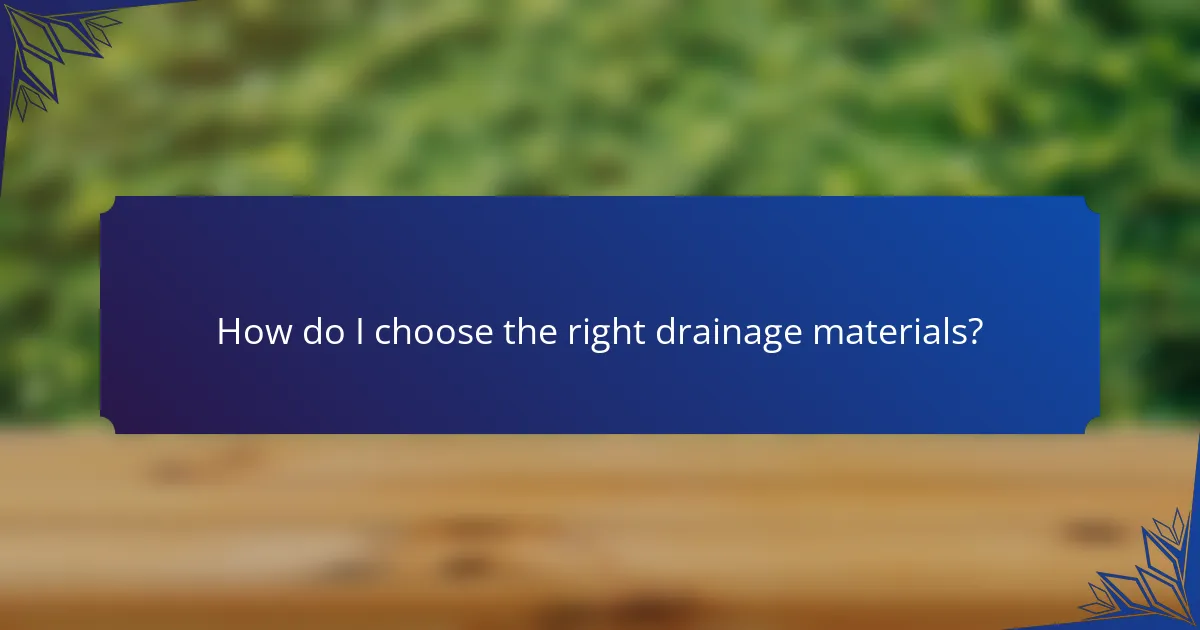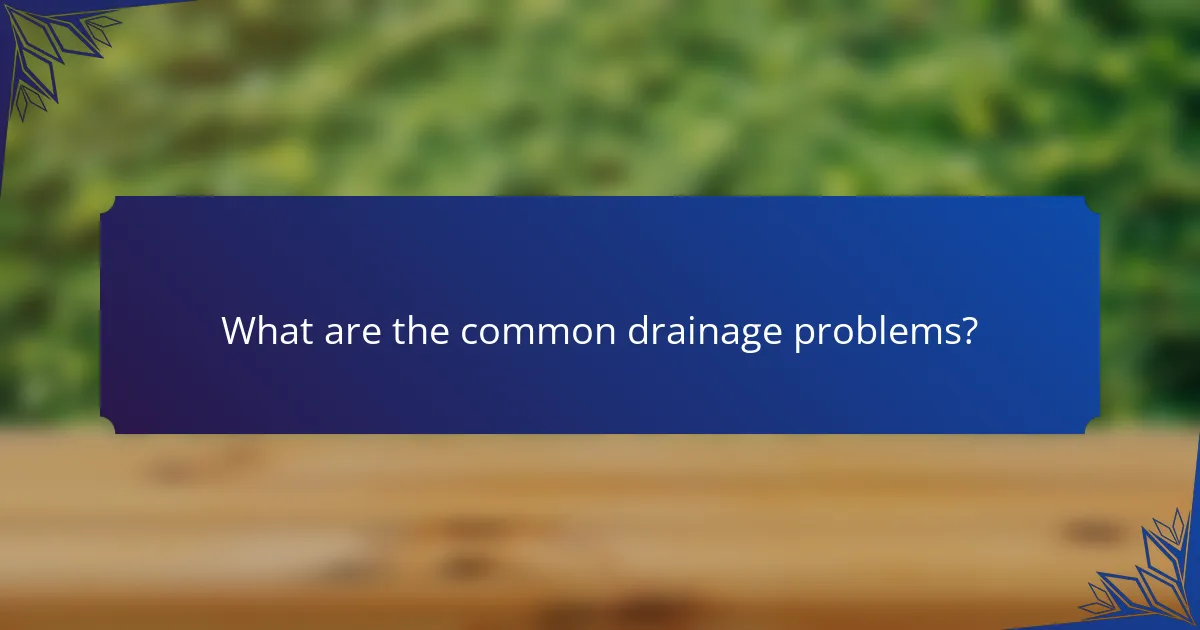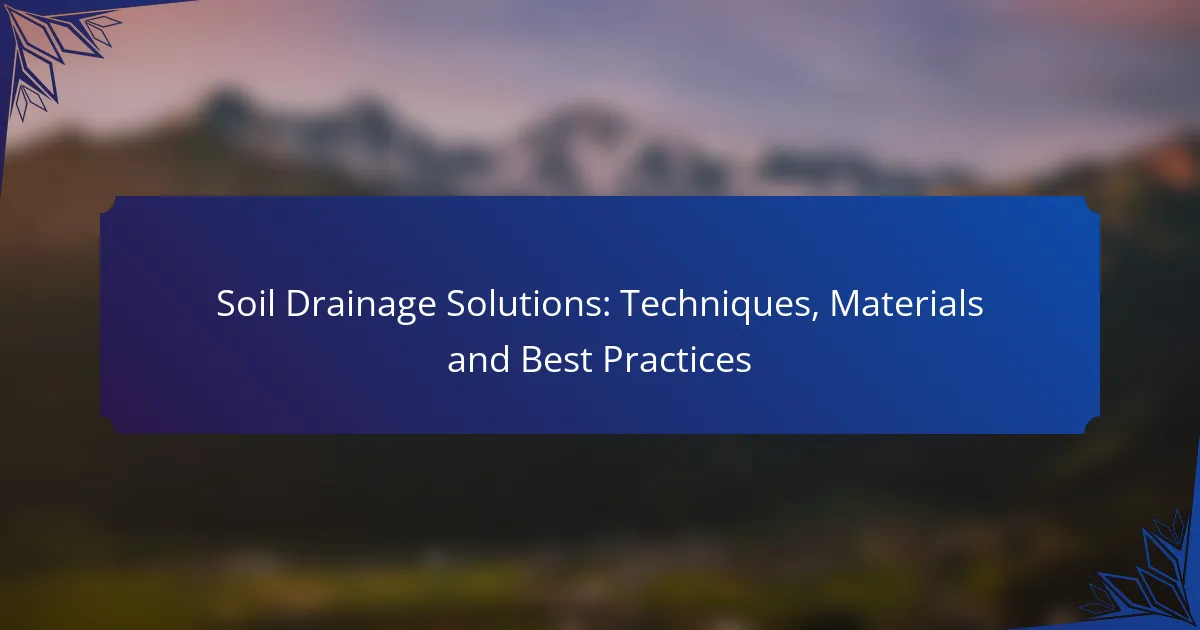Effective soil drainage solutions are essential for managing excess water in urban environments, helping to prevent flooding and enhance the landscape. Techniques such as French drains, permeable paving, and rain gardens can be employed to improve drainage. Selecting appropriate materials, including gravel and drainage pipes, is crucial for the success of these systems, while best practices in installation and maintenance ensure long-term effectiveness.

What are effective soil drainage solutions in urban areas?
Effective soil drainage solutions in urban areas help manage excess water and prevent flooding. Techniques such as French drains, permeable paving, and rain gardens can significantly improve drainage and enhance the urban landscape.
French drains
French drains consist of a trench filled with gravel or rock that directs water away from specific areas. They work by collecting surface and groundwater, allowing it to flow through perforated pipes and away from foundations or other structures.
When installing a French drain, ensure it is sloped away from buildings and that the trench is deep enough to handle expected water flow. Regular maintenance is essential to prevent blockages from debris and sediment.
Permeable paving
Permeable paving allows water to pass through the surface, reducing runoff and promoting groundwater recharge. Materials such as porous asphalt, permeable concrete, and interlocking pavers are commonly used.
Consider using permeable paving in driveways, parking lots, and walkways. Ensure proper installation with a suitable base layer to support the weight and prevent clogging. Regular cleaning may be necessary to maintain permeability.
Dry wells
Dry wells are underground structures designed to collect and temporarily store excess stormwater, allowing it to infiltrate into the surrounding soil. They help alleviate flooding by managing runoff from roofs and paved areas.
When installing a dry well, size it according to the drainage area it serves and ensure it is located away from structures. Regular inspection and maintenance are crucial to prevent sediment buildup and ensure proper function.
Swales
Swales are shallow, vegetated channels that convey and manage stormwater runoff. They slow down water flow, allowing for infiltration and reducing erosion while enhancing the landscape.
Design swales to follow the natural contours of the land and plant native vegetation to improve absorption and aesthetics. Avoid placing swales near building foundations to prevent water accumulation around structures.
Rain gardens
Rain gardens are planted depressions that capture and absorb rainwater from impervious surfaces. They are designed to filter pollutants and promote infiltration, improving water quality and reducing runoff.
To create a rain garden, select native plants that thrive in wet conditions and ensure the garden is located in a spot where it can collect runoff. Regular maintenance, including weeding and mulching, will help keep the garden healthy and effective.

How do I choose the right drainage materials?
Choosing the right drainage materials involves considering the specific needs of your project, such as soil type, water flow, and budget. Key materials include gravel, drainage pipes, and geotextiles, each serving distinct functions in managing water effectively.
Gravel types
Gravel is a crucial component for effective drainage, as it allows water to flow freely while providing structural support. Common types include crushed stone, pea gravel, and river rock, each with varying sizes and drainage capabilities. For most residential applications, a mix of 3/4-inch crushed stone works well, offering good drainage without excessive voids.
When selecting gravel, consider the local availability and cost. In the U.S., prices can range from $10 to $50 per cubic yard, depending on the type and region. Ensure the gravel is clean and free from fines to maximize drainage efficiency.
Drainage pipes
Drainage pipes are essential for directing water away from problem areas. Common materials include PVC, corrugated plastic, and concrete, with PVC being popular for its durability and ease of installation. The diameter of the pipe typically ranges from 4 to 6 inches for residential use, depending on the volume of water to be managed.
When installing drainage pipes, ensure they are sloped correctly, ideally at a gradient of 1-2% to facilitate water flow. Avoid using pipes that are too small, as this can lead to clogs and ineffective drainage.
Geotextiles
Geotextiles are permeable fabrics that help separate soil from drainage materials, preventing clogging while allowing water to pass through. They come in two main types: woven and non-woven, with non-woven geotextiles often preferred for drainage applications due to their superior filtration properties.
When using geotextiles, ensure they are placed correctly to cover the gravel or drainage layer completely. This helps maintain drainage efficiency and prolongs the lifespan of the system. Prices for geotextiles can vary, typically ranging from $0.50 to $2.00 per square foot, depending on the material and specifications.

What are best practices for installing drainage systems?
Best practices for installing drainage systems include thorough site assessment, proper slope design, and regular maintenance. These steps ensure effective water management and prevent issues like flooding or soil erosion.
Site assessment
Conducting a comprehensive site assessment is crucial before installing a drainage system. This involves evaluating soil type, topography, and existing water flow patterns. Understanding these factors helps in choosing the right drainage solution for your specific conditions.
Consider using tools like soil moisture meters and conducting percolation tests to gauge drainage capacity. Identifying potential obstacles, such as tree roots or underground utilities, can also prevent future complications.
Proper slope design
Proper slope design is essential for directing water away from structures and preventing pooling. A general rule is to maintain a slope of at least 1-2% away from foundations. This ensures that water flows efficiently towards designated drainage areas.
When designing slopes, avoid abrupt changes in grade, which can lead to erosion. Instead, create gentle transitions and consider using retaining walls or swales to manage water flow effectively.
Maintenance tips
Regular maintenance is vital for the longevity and effectiveness of drainage systems. Inspect drainage channels and pipes at least once a year, looking for blockages or signs of wear. Clearing debris and sediment buildup can significantly enhance water flow.
Additionally, check for signs of erosion around drainage areas and repair any damage promptly. Keeping vegetation trimmed and ensuring that downspouts are directed away from foundations can also help maintain optimal drainage performance.

What are the common drainage problems?
Common drainage problems include water pooling, soil erosion, and foundation damage. These issues arise from inadequate water management and can lead to significant structural and environmental concerns.
Water pooling
Water pooling occurs when excess water accumulates in low-lying areas, creating stagnant water bodies. This can happen due to poor grading, compacted soil, or insufficient drainage systems.
To address water pooling, consider installing surface drains or French drains to redirect water away from problem areas. Regular maintenance of gutters and downspouts is also crucial to prevent overflow.
Soil erosion
Soil erosion is the removal of the top layer of soil, often exacerbated by poor drainage practices. Heavy rainfall can wash away unprotected soil, leading to loss of nutrients and land degradation.
Implementing vegetation, such as grass or ground cover, can help stabilize soil and reduce erosion. Additionally, using retaining walls or terraces can effectively manage water flow and protect vulnerable areas.
Foundation damage
Foundation damage occurs when water seeps into the ground around a building’s foundation, causing it to shift or crack. This can be a result of poor drainage systems or improper grading.
To prevent foundation damage, ensure that downspouts direct water at least 3-4 feet away from the foundation. Installing a sump pump can also help manage excess water in basements or crawl spaces.

How does soil type affect drainage solutions?
Soil type significantly influences the effectiveness of drainage solutions due to variations in texture, structure, and permeability. Sandy soils typically drain quickly, while clay soils retain water, necessitating different approaches for effective drainage management.
Sandy Soil
Sandy soil has larger particles and higher permeability, allowing water to drain rapidly. This characteristic makes it less prone to waterlogging, but it can lead to insufficient moisture retention for plants. To enhance drainage in sandy soils, consider incorporating organic matter to improve nutrient retention.
Clay Soil
Clay soil consists of fine particles that compact easily, resulting in poor drainage and increased water retention. This can lead to issues like flooding and root rot. To improve drainage in clay soils, techniques such as installing drainage tiles or creating raised beds can be effective, allowing excess water to escape.
Loamy Soil
Loamy soil, a balanced mixture of sand, silt, and clay, offers good drainage while retaining moisture. This type of soil is ideal for gardening and landscaping. To maintain its drainage properties, avoid compaction and regularly add organic amendments to preserve its structure.
Soil Amendments
Adding soil amendments can significantly improve drainage across various soil types. Common amendments include compost, perlite, and gypsum. These materials can enhance soil structure, increase aeration, and promote better water movement, making them valuable for both sandy and clay soils.
Drainage Techniques
Implementing effective drainage techniques is crucial for managing different soil types. Options include surface drainage systems, subsurface drainage tiles, and swales. Each method should be tailored to the specific soil characteristics and landscape to optimize water flow and prevent erosion.
